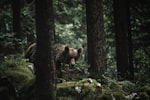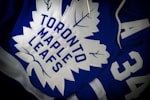(Note: I've hemmed and hawed over this one for a few days. I can't really bring myself to defend Harold Ballard, and yet I think everyone deserves a fair treatment - even Harold. In the end, I'm not so much trying to defend him as give a little more background into just where Harold came from. We all have a pretty good idea of what the results were. The thing that is so striking about Harold is not that it's this unbroken string of carnage, but rather that it isn't. Harold's first twenty years or so of Leaf experience weren't particularly bad. After he became an owner, maybe something snapped and the inner Harold was let loose. I don't know. There's more to read out there on the subject if I can bring myself to do it.)
In the first chapter of Leafs Abomination Feschuk and Grange devote a fair amount of text to explaining various ways in which Harold Ballard was a horrific owner.
They're right.
Ballard was a terrible owner. Of the 42 seasons in the current drought, a good 20 can be laid straight at the feet of Pal Hal. He was loud, brash, meddlesome and created an endless series of messes for his team and its fans. That paper bag on the cover of the book? I remember seeing those 25 years ago, back when the destruction was at its worst.
The story of Ballard would be a lot easier if it were all about the failures. The problem is that it isn't.
"Ballard's own history shows the kind of effect the guy could have on a hockey team. Before he began systematically stripping the Leafs of their intimidating reputation and their best players, Ballard coached an amateur team, the Toronto Sea Fleas, taking over behind the bench after Harry Watson stepped down in 1932. Ballard acknowledged he "didn't know any more about coaching a hockey team than Saint Peter knows about African golf."
"Dress up the Keystone Kops in hockey uniforms, throw in several scenes from the movie Slap Shot and you get an idea of what Ballard's attempt at coaching a hockey team was like," wrote William Houston. Sounds a lot like his work as a behind-the-scenes general manager too."
From the above comment plus the available evidence out there, it's probably fairly safe to say that Harold Ballard wasn't much of a coach. Under Ballard's coaching, those same Sea Fleas became the first Canadian team to actually lose a game at the World Championships, dropping a 2-1 overtime decision to the Americans in Prague in 1933. If you take this and then jump straight into the multiple fiascos of the 1970s and 1980s, you get a wonderful unbroken streak of incompetence - a nice easy storyline.
The thing is, though, most of Ballard's hockey experience came not as a coach, but as a manager - either running the hockey operation, the business, or both - and the truth of the matter is that he wasn't always all that bad at it. It doesn't fit the narrative to say it this way, of course. The story has always been that Harold was this evil destructive force that Conn Smythe didn't want near his Leafs, and that the old man was right.
I think, more than anything particularly evil, Harold Ballard is simply another example of the Peter Principle at work. He was a guy who had success running things at a particular level, then found himself front and centre on the biggest stage and all the checks and balances that might have allowed things to work either fell apart or he tore them apart. It also took a lot of lucky breaks - most of them bad (for the Leafs and their fans, anyway).
Harold Ballard came to hockey through his association with his father's skate-producing company. Though his original interest was in speed skating he ended up being the assistant manager of the 1928 Varsity Grads team that won the gold medal in the 1928 Olympics.
He was part of the National Yacht Club in the 1930s, which was the sponsor of the Sea Fleas team mentioned above. They won the 1932 Allan Cup with Ballard as business manager. By 1934, he was managing the West Toronto Nationals junior team and hired Leaf captain Hap Day as his coach. Together they won the 1936 Memorial Cup.
Day became Leaf coach in 1940 and it was he who recommended Ballard to run the Toronto Marlboros. He was both president and GM. The Marlies in those days were one of the two main Leaf junior teams, the other being St. Mike's. His first year was a great success but the Marlies struggled throughout the war years and didn't really get rolling again until late 40s. By 1949-50, they were tops in the OHA and they were a top-performing organization throughout most of the 1950s. They won Memorial Cups in 1955 and 1956 and it was the players on those teams - guys like Baun, Brewer, Nevin, Harris and Pulford - that would form the core of the Leaf resurgence in the late 1950s.
In the early 1950s, Ballard had hired Stafford Smythe to be the managing director of the Marlies. Interestingly, it was Ballard, not Smythe himself, that brought Conn's son into the Leaf organization. It was under the Stafford Smythe/Harold Ballard tandem that the Marlies saw their greatest triumphs.
Now, the Leafs of the 1950s were not doing as well as the Marlies had been. They hadn't won a Cup since 1951 and really hadn't been a contender at all. By 1957, the first appearances of guys like Duff, Harris and Mahovlich had occurred, but this was a team in serious need of a makeover. In March of that year, Conn Smythe put together a seven-person team (the "Silver Seven" - nothing like a borrowed name) to oversee the hockey operations. Stafford was one of them. By the end of the year, Ballard had joined them. At 54, Ballard was far and away the oldest. The rest were in their 30s or 40s.
The changes began in earnest in 1957-58. After 33 years spent with the Leafs in one form or another, assistant GM (GM in everything but title) Hap Day was thrown under the bus. Conn Smythe's role in hockey decisions would never be quite the same again as he became largely a figurehead in his own organization. The Silver Seven hired and fired a new GM, Leaf coach Howie Meeker, before the season even started. The committee ran the club themselves that year then hired King Clancy and Punch Imlach as assistant GMs for 1958-59. Within months Imlach was given the keys to everything and the Leafs set themselves up for the 1960s.
By November 1961 the Leafs were poised for greatness and Stafford was poised to buy out his father as majority owner of the Leafs. Unbeknownst to Conn (as the story goes), Stafford had two partners in John Bassett and Harold Ballard, with Ballard putting up most of the money. Stafford would be president and governor, Ballard executive VP and alternate governor and Bassett wound up as vice-chairman of the MLG board of governors.
The point I'm making here - again - is that it wasn't always bad under Stafford and Ballard - particularly as managers. Ballard had been around since 1940, Stafford about 10 years less. They played a big part in the 1950s changes that set up the 1960s glory. They ran the farm team that developed the players and they set up the management structure that got the big club back on the map.
The problems started once they became owners. It wouldn't become immediately apparent (mainly because the team was winning), but things would begin to go very, very badly. As with most things, it all came down to power and money.
Once in full control of the Gardens, Ballard and Smythe worked to increase its revenue-generating capacity. They sold tickets for a pair of Beatles concerts. The Beatles themselves had agreed to just one, but Ballard told them that if they just performed once, the ticket holders for the second show would tear them apart. The Beatles performed the second show. Ballard left the A/C off during the shows, all the better to sell soft drinks.
More controversial was a 1966 decision to host a Muhammad Ali title fight against George Chuvalo. Ali was then notorious for refusing to serve in the army and couldn't find a site in the US. Conn Smythe, the veteran of two world wars, was so upset by this that he left the organization, saying the Leafs now preferred cash over class.
Somewhere along the way, while making all this money for and through MLG, Ballard and Stafford Smythe began using the Gardens as their own private bank account, though primarily for withdrawals. In 1967, Cox and Stellick report that both had extensive work done to their homes, all paid by MLG. By 1968, the RCMP charged both with tax evasion and fraud. There was a coup and counter-coup with John Bassett after which Ballard and Smythe first forced Bassett out and then bought him out.
When Stafford Smythe suddenly died at the age of 50 in 1971, shortly before his trial was to begin, Ballard (then 68) suddenly found himself in the position of majority owner and this is where the fun really began. I don't know whether it stemmed from the time in 1969 when Bassett had him fired and he came this close to losing control of the whole thing, whether it was the loss of Stafford, who could make fairly sound hockey decisions and temper some of Ballard's excesses, whether it was the slap on the wrist he got for the crimes for which he was convicted, or whether it was something else entirely, but from 1971 onwards the show was all about Harold, and how he could do whatever he wanted, whenever he wanted.
Not everybody hated Harold Ballard and not everything he did was evil. He fronted Tim Horton $25K in an interest-free loan when Tim's fledgling donut chain desperately needed cash. He gave a lot to charities and left most of his estate to charity as well. It's not hard to find players (even those who played for the Leafs) who have good things to say about Pal Hal. (It is, however, every bit as easy to find players who won't have nice things to say....)
What was never allowed to happen, though, was that anyone's power begin to approach his own. This is just my opinion, but it would explain why you saw so many weak and/or inexperienced GMs and coaches put in place, and why they were all drummed out the minute it looked like they might be successful. This explains the troubles with Keon, with Sittler, with Eagleson. He wanted to win, but given the choice between winning and being front and centre, he'd choose the latter.
Despite everything, the Leafs put together some pretty promising teams. There was always the sense, though, that it would get screwed up somehow. It pretty much always did - and Harold was usually part of it.
it's hard to look at how things played out and not wonder how things might have been. Had John Basset really gone for the jugular in 1969, or had Stafford Smythe lived to continue influencing the Leafs, things might have worked out differently. They didn't, and we got what we got.
I'm not dead clear as to why this is our fault as fans but apparently it is.



